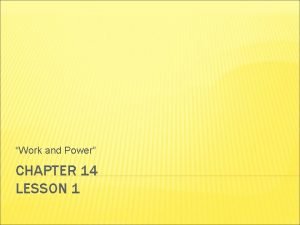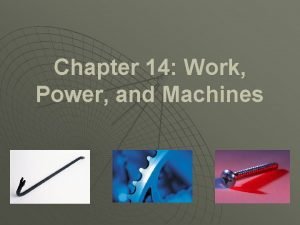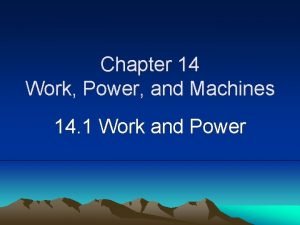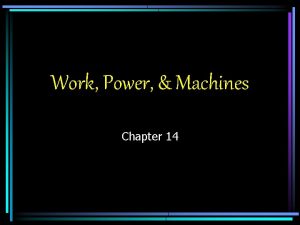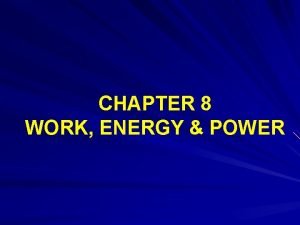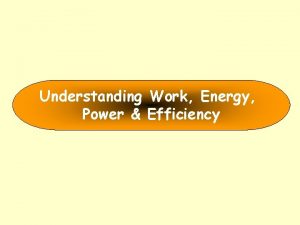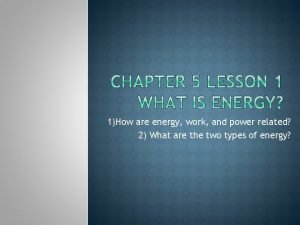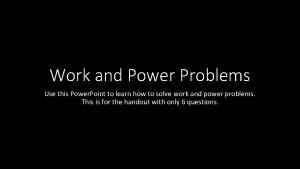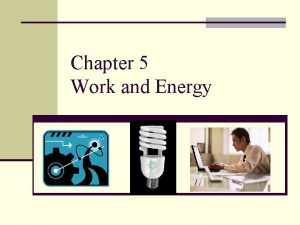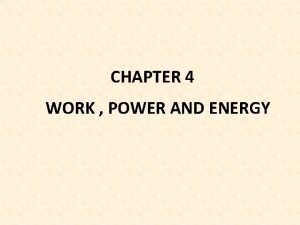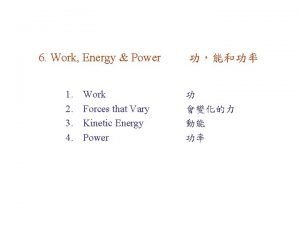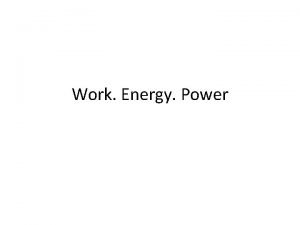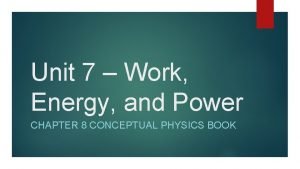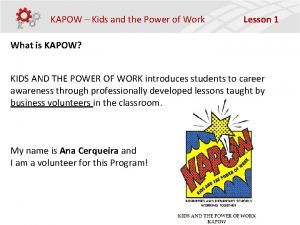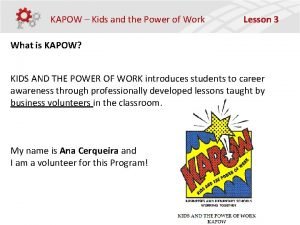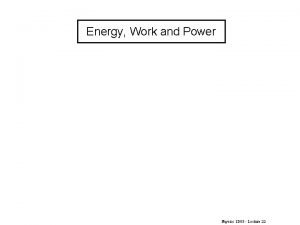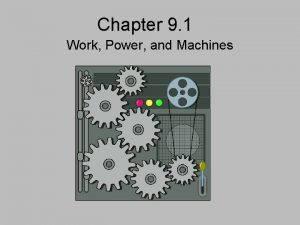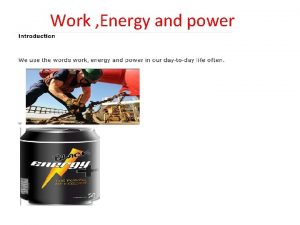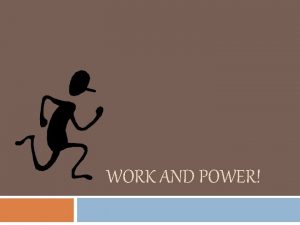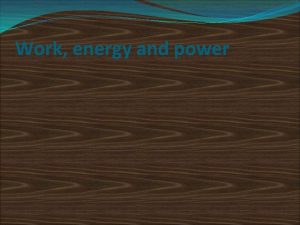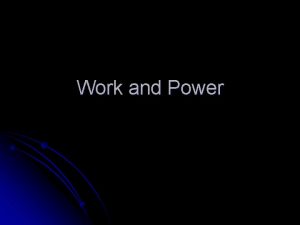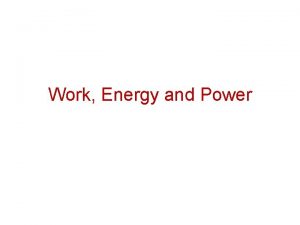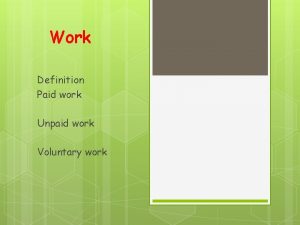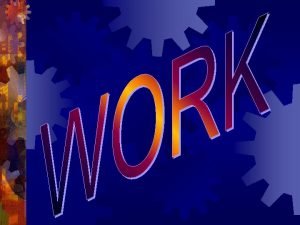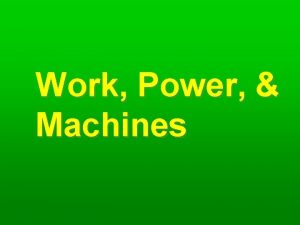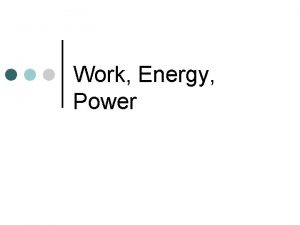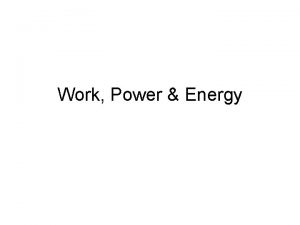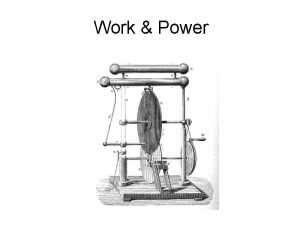CHAPTER 13 1 13 2 Work Power and





























- Slides: 29

CHAPTER 13. 1 & 13. 2 Work, Power and Machines

Section one: Work, Power, and Machines • Objective one: Calculate Work • Objective Two: Differentiate Work and Power • Objective Three: Discover that machines make work easier

Work • What is work? • To a scientist work is done when changing motion • Work is force applied multiplied by the distance the force acts • Only if the force and the direction are the same • Work is zero when an object is not moving

Work • When an Olympic weight lifter presses a barbell over his head he is doing work • When he has to hold it there until the judges say he can put it down he is not doing work • Big force but no distance

Is he doing any work on the barbell? • No • Work is zero when an object is stationary Video

Calculating Work • Work= force x distance • W=Fxd Units of work W • Force= Newton F • Distance= meters d • Work= Newton x meter (N·m) • N·m= 1 Joules (J) • Or kg·m 2/s 2 SI unit of work is Joules So if an apple weighs about 1 N and you lift it 1 meter. That is 1 N·m of work or 1 J of work

Practice Problem (Work) • 1. A crane uses an average force of 5, 200 N to lift a girder 25 m. How much work does the crane do on the girder? W=? F=5, 200 N d= 25 m W= F x d W= 5, 200 N x 25 m W= 130000 J W= 1. 3 x 105 J • 2. A bicycle’s brakes apply 125 N of frictional force to the wheels as the bike moves 14. 0 m. How much work do the brakes do? W=? F= 125 N d= 14. 0 m W= Fxd W = 125 N x 14. 0 m W = 1, 750 J

Practice Problem (Work) • 3. A mechanic uses a hydraulic life to raise a 1, 200 kg car 0. 50 m off the ground. How much work does the lift do on the car? W= F x d W=? F==? 11760 N F d = 0. 50 m F= m x a F= 1, 200 kg x 9. 8 m/s 2 W= 11760 N x 0. 50 m W= 5900 J W= 5880 J F= 11760 N • 4. A car has run out of gas. Fortunately, there is a gas station nearby. You must exert a force of 715 N on the car in order to move it. By the time you reach the station, you have done 2. 72 x 104 J of work. How far have you pushed the car? W = 2. 72 x 104 J F=715 N d= ? d= W/F d= 2. 72 x 104 J 715 N d= 38. 04 m d= 38. 0 m

Power • What is Power? • It is the rate at which work is done. • Quantity that measures work in relation to time. • Running up stairs is harder than walking up stairs • Why? They both do the same amount of work. • Running does the same work more quickly • Your power output would be greater than if you walked up the stairs. Video

Calculating Power • Power is work divided by time • Power = w/t • SI units for power is watts (W) • 1 watt is the power to do 1 J of work in 1 s • Watt= Joule W P second A student lifts a 12 N textbook 1. 5 m of the floor in 1. 5 s. How much work did he do? W=fxd W = 12 N x 1. 5 m W = 18 J How much power did he use? P = W/t P = 18 J/ 1. 5 s P = 12 W t

Practice Problem (Power) 1. A 43 N force is exerted through 2. 0 m distance for 3. 0 s. How much work was done? W= ? F= 43 N d= 2. 0 m W=fxd W =43 N x 2. 0 m How much power was used? P= ? W= 86 J t= 3. 0 s P = W/t P = 86 J / 3. 0 s P = 28. 66 W P = 30 W W = 86 J

Practice Problem (Power) 2. While rowing across the lake during a race, John does 3, 960 J of work on the oars in 60. 0 s. What is his power output in watts? P= 66 W P= W/t W= 3, 960 J t= 60. 0 s P= 3960 J / 60. 0 s P= 66. 0 W 3. Anna walks up the stairs on her way to class. She weighs 565 N, and the stairs go up 3. 25 m vertically. Figure out work first a. If Anna climbs the stairs in 12. 6 s, what is her power output? P=145. 73 W P=W/t W= ? F= 565 N d= 3. 25 W= F x d W= 1836. 25 J t= 12. 6 s P=1836. 25 J /12. 6 s P= 146 W b. What is her power output if she climbs the stairs I n 10. 5 s? P= ? W= 1836. 25 J t= 10. 5 s P=W/t P=1836. 25 J / 10. 5 s P=174. 88 W P=175 W

Machines • Machines make work easier. • They multiply force or change its direction • They multiply force by using a small force to go a long distance • Things like ramps, levers, etc.

W = 75 N x 1 m = 75 J W = 25 N x 3 m = 75 J 25 N 13 m m 75 N

Mechanical Advantage • How many times a machine multiplies the input force • Mechanical advantage greater than 1 multiples force • Less than 1 it multiplies distance, less force F Calculating Mechanical Advantage • Mechanical Advantage = output force input force • Mechanical Advantage = input distance output distance • MA has no SI unit • Force is still Newtons out F MA in D in MA D out

Practice Problem (Mechanical Advantage) 1. Find the mechanical advantage of a ramp that is 6. 0 m long and 1. 5 m tall. MA = input distance/output distance MA = 6. 0 m/1. 5 m MA = 4. 0 • So, what was increased? Force, because it was great than 1 2. Alex pulls on the handle of a claw hammer with a force of 15 N. If the hammer has a mechanical advantage of 5. 2, how much force is exerted on the nail in the claw? F out= ? MA =5. 2 F in = 15 N F out= MA x F in F out= 5. 2 x 15 N F out= 78 N

13. 2 Simple Machines • Identify the six types of Simple Machines. • What are the parts of a lever? • How does using a simple machine change the force required to do work? • Identify compound machines.

What is a Simple Machine? • A simple machine has few or no moving parts. • Simple machines make work easier

The Lever Family • First, second, and third class levers • Pulleys • Wheel and axles • MA = di/do • MA = Fo/Fi i = input What you do. o= output The Resistance

Levers-First Class • In a first class lever the fulcrum is in the middle and the load and effort is on either side • Think of a see-saw

Levers-Second Class • In a second class lever the fulcrum is at the end, with the load in the middle • Think of a wheelbarrow

Levers-Third Class • In a third class lever the fulcrum is again at the end, but the effort is in the middle • Think of a pair of tweezers

Pulleys • Pulley are wheels and axles with a groove around the outside • A pulley needs a rope, chain or belt around the groove to make it do work • Single fixed pulley MA = 1 • Single moveable pulley MA = 2 • Block and Tackle MA = # of lines that support the weight of the Resistance.

Wheels and Axles • The wheel and axle are a simple machine • The axle is a rod that goes through the wheel which allows the wheel to turn • Gears are a form of wheels and axles • MA = Radius of Wheel/Radius of axle

The Inclined Plane Family • Ramps • Wedges • Screws • MA = di/do • MA = Fo/Fi i = input What you do. o= output The Resistance Like Levers

Inclined Planes • An inclined plane is a flat surface that is higher on one end • Inclined planes make the work of moving things easier

Wedges • Two inclined planes joined back to back. • Wedges are used to split things.

Screws • A screw is an inclined plane wrapped around a shaft or cylinder. • The inclined plane allows the screw to move itself when rotated.

Compound Machines • Compound machine: a machine that combines more than one simple machine. • Simple Machines can be put together in different ways to make complex machinery
 Power trianlge
Power trianlge Chapter 4 section 1 work and machines answer key
Chapter 4 section 1 work and machines answer key Unit 14 lesson 1 drivers ed
Unit 14 lesson 1 drivers ed Chapter 14 work power and machines
Chapter 14 work power and machines Chapter 14 section 1 work and power
Chapter 14 section 1 work and power Chapter 14 work power and machines
Chapter 14 work power and machines Chapter 8 work and power answers
Chapter 8 work and power answers Solar power satellites and microwave power transmission
Solar power satellites and microwave power transmission Potential power
Potential power Define dispersive power of a grating
Define dispersive power of a grating Work power and efficiency
Work power and efficiency Define work and power
Define work and power What is work in physics
What is work in physics How to calculate work and power
How to calculate work and power Work, power and energy activities
Work, power and energy activities Work defined in physics
Work defined in physics How are work and power related
How are work and power related Hans full is pulling on a rope to drag
Hans full is pulling on a rope to drag Work power energy and machines
Work power energy and machines W=fdcosθ meaning
W=fdcosθ meaning Work and power definition
Work and power definition Work power and energy
Work power and energy Work versus energy
Work versus energy Unit 7 work energy and power answers
Unit 7 work energy and power answers Kapow kids
Kapow kids Kids and the power of work
Kids and the power of work Work done equation
Work done equation A crate of bananas weighing 3000 n
A crate of bananas weighing 3000 n Hard work vs smart work presentation
Hard work vs smart work presentation Physics 03-06 impulse and momentum answer key
Physics 03-06 impulse and momentum answer key


